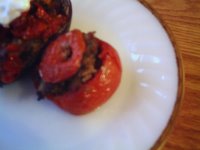I’m seeing a flurry of butternut squash recipes around the blogosphere, and so, fall begins. No complaints from me; in fact, late summer and early fall are my favorite food seasons. I began going to farmer’s markets weekly in early July but I didn’t really get excited about seasonal eating until August. For the past month I’ve been lugging home bags of eggplant, corn, zucchini, green and red peppers and tomatoes. I used to make ratatouille every weekend and when I got tired of it I made eggplant parmesan, corn chowder,
zucchini and yellow squash gratin and stuffed vegetables--eggplant, zucchini, tomatoes, etc.
Soon I’ll be moving on to apples, hard squash, fall spices (nutmeg, cloves), hot soups, turkey, sweet potatoes, stews, and pumpkin everything. This fabulous time of the year stretches from early August until just past Thanksgiving and tapers off completely after New Year’s. Come January I’ll be buying indifferent vegetables from the supermarket and by February I’ll be craving late-August tomatoes and farmer’s market cucumbers while

peeling rutabagas.
Spring is my least favorite season when it comes to both food and weather.* March and April are disappointing months in Wisconsin. They hold the promise of warmth, lighter, fresher food, and the first days of sandal weather. They deliver a snow storm or two, temperatures no higher than the middling 50s and, at best, supermarket asparagus. What’s in season in Wisconsin in the spring? Not much, unless you get excited by rhubarb in May, and I don’t. Do people on the East Coast and in the Midwest really cook the light, spring-like dishes that food magazines feature on the covers of their March issues?
I don’t have strong opinions about June. Strawberries are in season, which is nice but would be nicer if they weren’t so expensive. I tried to be a good, seasonal foodie this year and eat salads and lighter, brighter food but I still craved hot soups in early June. June weather is a little tenuous; there’s a slight chill in the air in the morning and at night. December is another mixed bag. On one hand, you can bake and eat your fill of rich goodies with impunity, being the holiday season and all. On the other hand, all that baking and short, cold days eventually make everyone feel fat and sink deeper into the couch.
Now, in early September, there’s just a slight chill in the mornings but it’s welcoming to me as it hints at upcoming events that may be marked by food. My birthday (Sept. 29), my family’s anniversary of coming to America (Oct. 24; last year we were all multi-culti and went out to an Indian restaurant), Halloween (leftover candy, especially Twix and Mars bars), Thanksgiving (my favorite holiday), Christmas and New Year (a big deal for us Russkies; can’t wait for my once-a-year taste of caviar).

For those dreading the inevitable chill of fall, here’s a late-summer stuffed eggplant recipe. There’s still time to make this.
I sliced three
small eggplants across lengthwise and scooped out the flesh with a sharp spoon. The eggplant shells I broiled for about 20-25 minutes. In the meantime, I made my usual lamb and rice stuffing, loosely based on a recipe in Anya von Bremzen’s
Please to the Table. I sautéed half an
onion, added
ground lamb—a little less than ½ pound—and spiced with
cinnamon,
allspice,
cayenne and
salt. This I sautéed until the lamb was done.
Then I added a couple of peeled, chopped
tomatoes and simmered the mixture for a little while. In the meantime I sautéed the eggplant pulp separately, and, when it was soft, folded it into the lamb, along with some cooked
rice. After stuffing the eggplants I ended up with some leftovers so I stuffed a few tomatoes as well. The vegetable went into a casserole pan into which I poured a little tomato sauce (a very basic marinara that I made to de-glut my kitchen counters of tomatoes). I baked all this at 425 for about 20-25 minutes and let the vegetables stand for 15 minutes before eating. They’re best lukewarm or at room temperature.
* Based on my experience, of course. I was born and raised in the cold climates. The warmest place I’ve ever lived in was Columbus, Ohio.
 Some people think of stuffed peppers as heavy winter fare, but I think of them as excellent late summer food. Peppers are cheap at farmer's markets in late August and early September: I bought five for a buck last week. I stuffed them with my usual lamb and rice filling. After simmering in tomato sauce, made of excellent local tomatoes, for an hour, the peppers were ready. The peppers are the latest in my series of stuffed summer vegetables. So far I've stuffed: zucchini, round zucchini, eggplant and tomatoes.
Some people think of stuffed peppers as heavy winter fare, but I think of them as excellent late summer food. Peppers are cheap at farmer's markets in late August and early September: I bought five for a buck last week. I stuffed them with my usual lamb and rice filling. After simmering in tomato sauce, made of excellent local tomatoes, for an hour, the peppers were ready. The peppers are the latest in my series of stuffed summer vegetables. So far I've stuffed: zucchini, round zucchini, eggplant and tomatoes.





